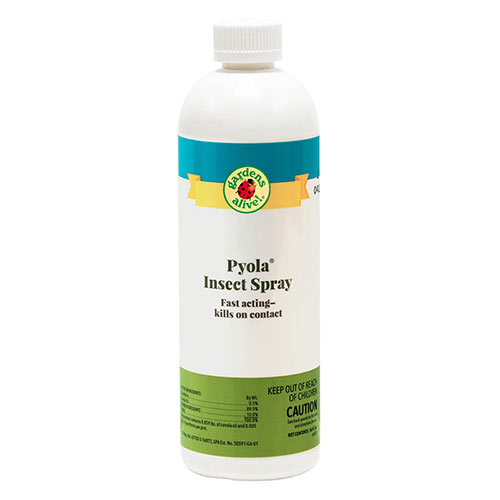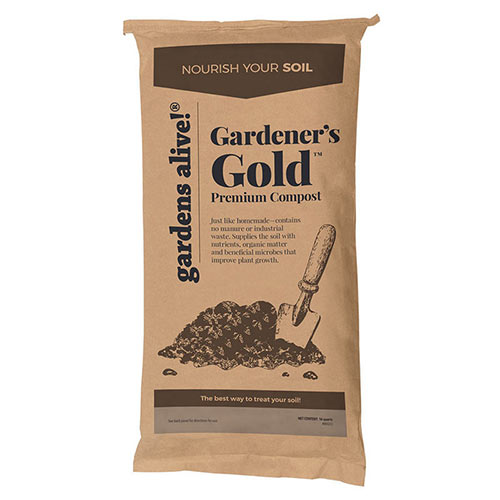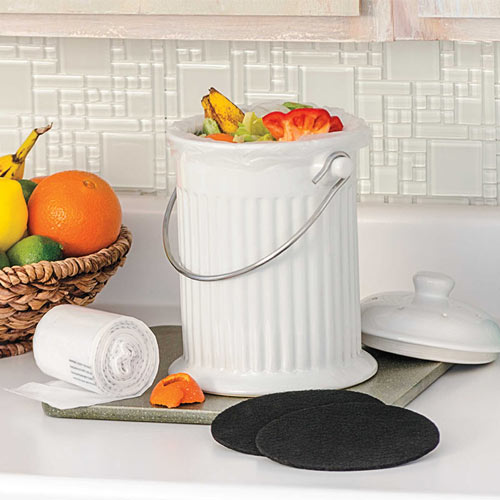Tree Stump = Compost—with no work!
-
Helpful Products from Gardens Alive!
-
 Pyola® Insect Spray
Pyola® Insect Spray -
 Gardener's Gold™ Premium Compost
Gardener's Gold™ Premium Compost -
 Compost Alive!® Activator with Quick-Start™ for Dry Plant Matter
Compost Alive!® Activator with Quick-Start™ for Dry Plant Matter -
 Ceramic Compost Crock
Ceramic Compost Crock
Q. Alene in Silver Spring—yes, the same Arlene who supplied last week's querulous question—writes: "Four winters ago, we cut down a tree that had about a ten-inch trunk, leaving a stump of about 2 1/2 feet high. I took a plastic composter and dropped it over the stump, and for four seasons filled the composter with chopped leaves and coffee grounds. Each year I would remove the compost and fill it again. The stump did not appear to be rotting at all.
"Until THIS Fall, when I emptied the composter and the stump was gone! In its place was the softest black compost I have ever seen. I was able to scoop out about two feet of this 'tree compost'. A nice experience and a bit of a surprise."
A. Nice experience certainly, but no surprise Arlene! As those of us of a certain age realize all too well, everything returns to the earth sooner or later—and it's going to happen sooner if you drop a composter on top of it and fill it with shredded leaves and coffee grounds. In other words, this is a great way to deal with a tree stump!
Now, let's review the rules of tree-cutting-down. When a tree is dead, fatally diseased or infested, baseball bat-ugly or in the way of everything else you want to do, you should proceed thoughtfully—and certainly not like me when I bought our house thirty years ago and didn't know it was unwise to use a fourteen-inch Playschool electric chain saw to take down full-grown tulip poplars. (I can still hear that could-have-been-fatal "crack!" when I was only halfway through one and suddenly had to think "am I upwind? Or downwind?")
Anyway, if the tree is far away from foundations, water lines and the like and you want to immediately plant something like a garden where it stood—and you can afford it—you should have the stump pulled when the tree is removed. Whatever you do—and despite all you will be assured—do not have the stump 'ground down'. You will soon learn that there is a giant plug in the soil that prevents planting and lots and lots of mushrooms popping up from where the roots are (very slowly) decomposing.
If you plan on using an adjacent area and the tree was simply throwing too much shade, consider leaving a 'snag' behind. That means delimbing and cutting the old tree down to six to ten feet tall. The shade from the remaining giant Popsicle will be minimal, and the dead trunk will soon be home to all kinds of birds that eat insect pests.
Woodpeckers, of course, but after the woodpeckers make the primary nesting holes (thus not trying to do it in the side of your house, which is a real plus), those nests will be reused by chickadees (the number one bad insect-eating bird), owls (THE primary predator of voracious voles) plus nuthatches, bluebirds, flycatchers, swallows, titmice, wrens, and warblers.
Just make sure it won't fall on your house in ten years and don't plant anything flat-earth style inside of the tree's drip line—an area approximately as wide as the furthest branches reached in life. (Actually it's a little further out than that, but the 'furthest branch' rule covers where the really big roots are lurking.) But hey—if you're taking a tree down, go the extra mile and build raised beds—you'll cut your weed woes by 90% and, as the legendary John Jeavons famously explained, "you'll grow twice as much in half the space".
Back to StumpyTown: If, like our repeat offender Arlene, you currently have a small stump, by all means imitate her actions and make compost around it. It doesn't really matter whether you use a big wire cage or one of those nifty black plastic composters with a locking lid—just fill it with shredded leaves and spent grounds from your local coffee shop and you will achieve two ends. One, you will, over a period of years, get that stump to also become compost; and two, you will finally stop tripping over the dang thing—which is kind of funny when you're nineteen but means you'll need a new knee at my age.
One exception: If you're going to add kitchen waste to the mix, be sure to use the locking lid style—unless you want to help your local mouse, rat and raccoon population feed and flourish. (Worm bins are and will always be the best way to turn kitchen waste into garden gold—and they [really!] make a great holiday gift!)
And there's also my old-tried-and-true answer to short tree stump blues: Box off the area around the stump as if you're just building a singular raised bed, but make the height at least a foot and preferably taller. Then fill the bed with annuals— flowers or food plants—and feed it a little more Nitrogen than you would otherwise use. The rotting stump in the center of your bed will suck up some of the available Nitrogen at the root zone as it slowly decomposes, so compensate for that—but no chemical nitrogen and nothing over a ten on the NPK reading on the label.
You'll get a nice harvest of food and or flowers. And you won't need a new knee. That's always a plus.
"Until THIS Fall, when I emptied the composter and the stump was gone! In its place was the softest black compost I have ever seen. I was able to scoop out about two feet of this 'tree compost'. A nice experience and a bit of a surprise."
A. Nice experience certainly, but no surprise Arlene! As those of us of a certain age realize all too well, everything returns to the earth sooner or later—and it's going to happen sooner if you drop a composter on top of it and fill it with shredded leaves and coffee grounds. In other words, this is a great way to deal with a tree stump!
Now, let's review the rules of tree-cutting-down. When a tree is dead, fatally diseased or infested, baseball bat-ugly or in the way of everything else you want to do, you should proceed thoughtfully—and certainly not like me when I bought our house thirty years ago and didn't know it was unwise to use a fourteen-inch Playschool electric chain saw to take down full-grown tulip poplars. (I can still hear that could-have-been-fatal "crack!" when I was only halfway through one and suddenly had to think "am I upwind? Or downwind?")
Anyway, if the tree is far away from foundations, water lines and the like and you want to immediately plant something like a garden where it stood—and you can afford it—you should have the stump pulled when the tree is removed. Whatever you do—and despite all you will be assured—do not have the stump 'ground down'. You will soon learn that there is a giant plug in the soil that prevents planting and lots and lots of mushrooms popping up from where the roots are (very slowly) decomposing.
If you plan on using an adjacent area and the tree was simply throwing too much shade, consider leaving a 'snag' behind. That means delimbing and cutting the old tree down to six to ten feet tall. The shade from the remaining giant Popsicle will be minimal, and the dead trunk will soon be home to all kinds of birds that eat insect pests.
Woodpeckers, of course, but after the woodpeckers make the primary nesting holes (thus not trying to do it in the side of your house, which is a real plus), those nests will be reused by chickadees (the number one bad insect-eating bird), owls (THE primary predator of voracious voles) plus nuthatches, bluebirds, flycatchers, swallows, titmice, wrens, and warblers.
Just make sure it won't fall on your house in ten years and don't plant anything flat-earth style inside of the tree's drip line—an area approximately as wide as the furthest branches reached in life. (Actually it's a little further out than that, but the 'furthest branch' rule covers where the really big roots are lurking.) But hey—if you're taking a tree down, go the extra mile and build raised beds—you'll cut your weed woes by 90% and, as the legendary John Jeavons famously explained, "you'll grow twice as much in half the space".
Back to StumpyTown: If, like our repeat offender Arlene, you currently have a small stump, by all means imitate her actions and make compost around it. It doesn't really matter whether you use a big wire cage or one of those nifty black plastic composters with a locking lid—just fill it with shredded leaves and spent grounds from your local coffee shop and you will achieve two ends. One, you will, over a period of years, get that stump to also become compost; and two, you will finally stop tripping over the dang thing—which is kind of funny when you're nineteen but means you'll need a new knee at my age.
One exception: If you're going to add kitchen waste to the mix, be sure to use the locking lid style—unless you want to help your local mouse, rat and raccoon population feed and flourish. (Worm bins are and will always be the best way to turn kitchen waste into garden gold—and they [really!] make a great holiday gift!)
And there's also my old-tried-and-true answer to short tree stump blues: Box off the area around the stump as if you're just building a singular raised bed, but make the height at least a foot and preferably taller. Then fill the bed with annuals— flowers or food plants—and feed it a little more Nitrogen than you would otherwise use. The rotting stump in the center of your bed will suck up some of the available Nitrogen at the root zone as it slowly decomposes, so compensate for that—but no chemical nitrogen and nothing over a ten on the NPK reading on the label.
You'll get a nice harvest of food and or flowers. And you won't need a new knee. That's always a plus.
-
Helpful Products from Gardens Alive!
-
 Pyola® Insect Spray
Pyola® Insect Spray -
 Gardener's Gold™ Premium Compost
Gardener's Gold™ Premium Compost -
 Compost Alive!® Activator with Quick-Start™ for Dry Plant Matter
Compost Alive!® Activator with Quick-Start™ for Dry Plant Matter -
 Ceramic Compost Crock
Ceramic Compost Crock







 Gardens Alive! & Supplies
Gardens Alive! & Supplies




